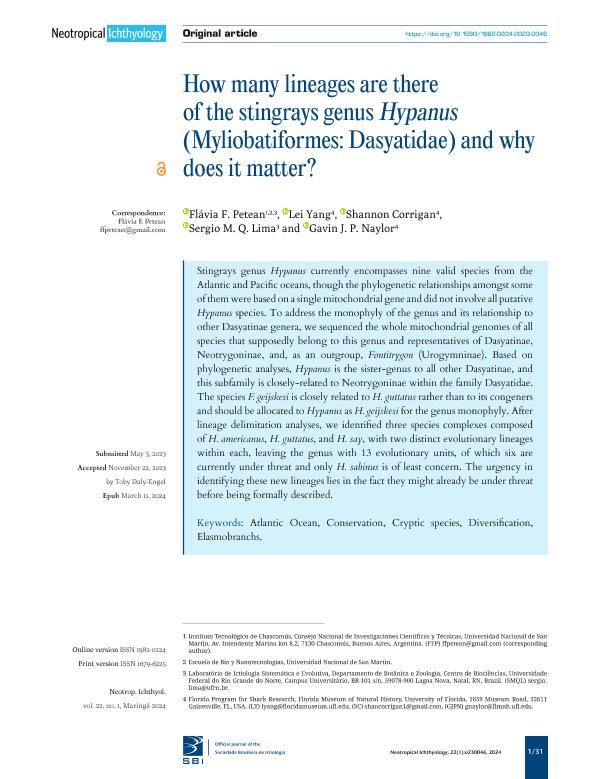Artículo
How many lineages are there of the stingrays genus Hypanus (Myliobatiformes: Dasyatidae) and why does it matter?
de Figueiredo Petean, Flávia ; Yang, Lei; Corrigan, Shannon; Lima, Sergio M. Q.; Naylor, Gavin J. P.
; Yang, Lei; Corrigan, Shannon; Lima, Sergio M. Q.; Naylor, Gavin J. P.
 ; Yang, Lei; Corrigan, Shannon; Lima, Sergio M. Q.; Naylor, Gavin J. P.
; Yang, Lei; Corrigan, Shannon; Lima, Sergio M. Q.; Naylor, Gavin J. P.
Fecha de publicación:
03/2024
Editorial:
Sociedade Brasileira de Ictiologia
Revista:
Neotropical Ichthyology
ISSN:
1679-6225
e-ISSN:
1982-0224
Idioma:
Inglés
Tipo de recurso:
Artículo publicado
Clasificación temática:
Resumen
Stingrays genus Hypanus currently encompasses nine valid species from the Atlantic and Pacific oceans, though the phylogenetic relationships amongst some of them were based on a single mitochondrial gene and did not involve all putative Hypanus species. To address the monophyly of the genus and its relationship to other Dasyatinae genera, we sequenced the whole mitochondrial genomes of all species that supposedly belong to this genus and representatives of Dasyatinae, Neotrygoninae, and, as an outgroup, Fontitrygon (Urogymninae). Based on phylogenetic analyses, Hypanus is the sister-genus to all other Dasyatinae, and this subfamily is closely-related to Neotrygoninae within the family Dasyatidae. The species F. geijskesi is closely related to H. guttatus rather than to its congeners and should be allocated to Hypanus as H. geijskesi for the genus monophyly. After lineage delimitation analyses, we identified three species complexes composed of H. americanus, H. guttatus, and H. say, with two distinct evolutionary lineages within each, leaving the genus with 13 evolutionary units, of which six are currently under threat and only H. sabinus is of least concern. The urgency in identifying these new lineages lies in the fact they might already be under threat before being formally described.
Palabras clave:
ATLANTIC OCEAN
,
CONSERVATION
,
CRYPTIC SPECIES
,
DIVERSIFICATION
,
ELASMOBRANCHS
Archivos asociados
Licencia
Identificadores
Colecciones
Articulos(CCT - LA PLATA)
Articulos de CTRO.CIENTIFICO TECNOL.CONICET - LA PLATA
Articulos de CTRO.CIENTIFICO TECNOL.CONICET - LA PLATA
Citación
de Figueiredo Petean, Flávia; Yang, Lei; Corrigan, Shannon; Lima, Sergio M. Q.; Naylor, Gavin J. P.; How many lineages are there of the stingrays genus Hypanus (Myliobatiformes: Dasyatidae) and why does it matter?; Sociedade Brasileira de Ictiologia; Neotropical Ichthyology; 22; 1; 3-2024; 1-31
Compartir
Altmétricas



